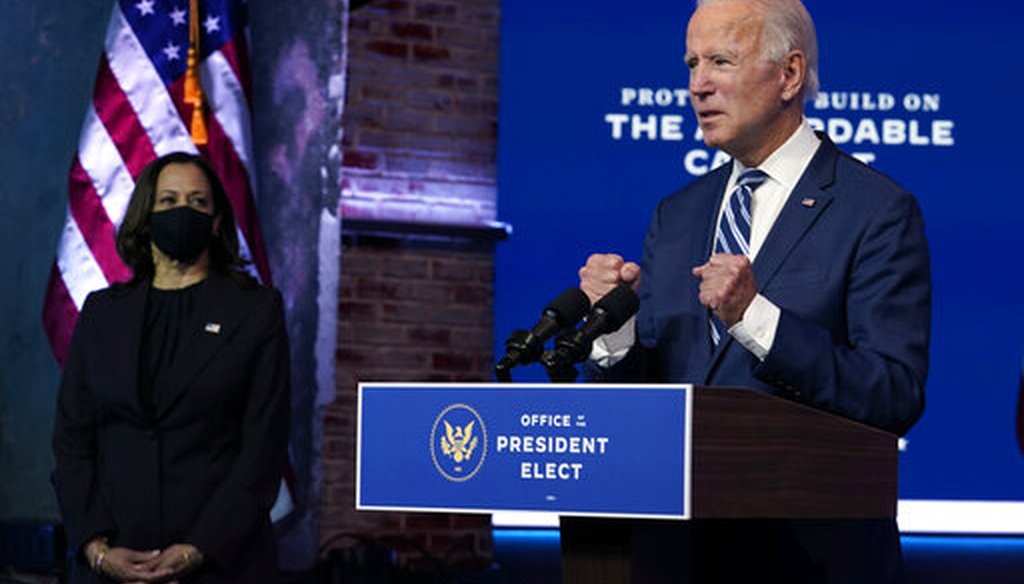Stand up for the facts!
Our only agenda is to publish the truth so you can be an informed participant in democracy.
We need your help.
I would like to contribute

President-elect Joe Biden speaks on Nov. 10, 2020, in Wilmington, Del. (AP )
If Your Time is short
• Joe Biden is expected to win 306 electoral votes, the same as Donald Trump won four years ago.
• Biden has amassed a wider margin in popular votes than any candidate since 1996 except for Obama in 2008.
• Biden’s relatively narrow margin of victory in swing states, especially in Pennsylvania, suggests that a future Republican candidate will still have an advantage in the Electoral College.
EDITOR'S NOTE: This story has been updated to reflect vote tallies as of Nov. 25, 2020.
How big was Joe Biden’s victory in the presidential race? It wasn’t a landslide, but it was decisive, the numbers show.
Biden’s Electoral College victory will be exactly the same as Trump’s in 2016: They both will have won states totaling 306 electoral votes.
Four years ago, Trump declared this number of electoral votes to be "a massive landslide." We rated that False, noting that 306 electoral votes ranks no better than the bottom quarter of Electoral College showings in American history, and no better than the bottom one-third of the showings since the end of World War II.
This means it would be equally inaccurate to claim that Biden’s win was a "massive landslide" in the electoral college.
Sign up for PolitiFact texts
However, the more restrained characterization by former President Barack Obama — that Biden’s victory was "decisive" — is well-supported.
Biden’s electoral vote total, like Trump’s, "was on the low side," said John J. Pitney Jr., a Claremont McKenna College political scientist. "The big difference, of course, is that Trump lost the popular vote. Biden is winning a majority of the popular vote, and by a healthy margin."
First, let’s look at the electoral vote.
Biden’s expected 306 electoral votes would be higher than either victory by George W. Bush, who accumulated only 271 in 2000 and 286 in 2004. It would also be slightly larger than the number won by Jimmy Carter in 1976, Richard Nixon in 1968, and John F. Kennedy in 1960.
Biden’s achievement is especially notable since it occurred during a period known for high partisan polarization, experts say.
"The era of landslide elections appears to be behind us," said Barry Burden, a University of Wisconsin-Madison political scientist. "The strengthening of partisanship in the electorate has dampened the magnitude of swings from one party to the other."
An even stronger sign of Biden’s decisive victory is the popular vote. The popular vote doesn’t determine the presidential victor — otherwise we would have had President Al Gore and President Hillary Clinton — but comparing the margin of Biden’s popular-vote victory with that of his predecessors suggests how broad-based his support was this year.
As of Nov. 25, Biden was leading in the popular vote tally by 6.26 million votes, according to the Cook Political Report's 2020 National Popular Vote Tracker. This number will probably expand, since late-counted votes in such solidly blue states as California and New York are expected to bolster Biden’s count more than Trump’s.
Alan Abramowitz, an Emory University political scientist, said Biden’s national popular vote edge could eventually reach 7 million votes.
Even before any of these late-counted votes are added to his tally, Biden has amassed a wider popular vote margin than any candidate since 1996 except for Obama in 2008, who won by more than 9.5 million votes.
So Biden’s popular-vote margin is already wider than the reelection victories of George W. Bush and Obama. It’s also wider than the popular-vote victories of Al Gore in 2000 and Hillary Clinton in 2016, both of whom lost the electoral vote. And it's wider than Bill Clinton amassed in his first victory in 1992.
Arguably an even larger measure of Biden’s win is his percentage of the popular vote. So far, Biden has secured 51.1% of the vote, though that could rise slightly with the addition of votes still to be counted.
Since 1932, when Franklin D. Roosevelt ousted President Herbert Hoover amid the Great Depression, Biden’s percentage of the vote ranks as the third-highest for a candidate whose party did not hold the White House.
The only higher percentages were the 55% by Dwight Eisenhower, the Republican running to succeed Democrat Harry Truman in 1952, and the nearly 53% by Obama, who was running to succeed Republican George W. Bush in 2008.
Eisenhower and Obama were running in open contests, where the sitting president wasn’t a candidate. Biden’s victory, notably, came against an incumbent, making his 2020 percentage the highest for a candidate facing an incumbent since Roosevelt in 1932.
We looked at the collective margins for the seven closest states in the four close elections in recent history: 2000, 2004, 2016 and 2020.
Collectively, the margins in 2020 were wider than any of the other three elections, and they could grow as ballots continue to be counted. (The seven closest states we looked at for 2020 were, in descending order, Arizona, Georgia, Wisconsin, Nevada, North Carolina, Maine, and Pennsylvania. We excluded non-competitive states such as Delaware and Wyoming.)
The 2000 election remains the benchmark for a close election. The seven closest states that year — Florida, New Mexico, Wisconsin, Iowa, Oregon, New Hampshire and Nevada — collectively had just a 46,000-vote margin.
By contrast, the seven closest states in 2020 currently have a collective margin of 311,654 — almost seven times wider than in 2000. And while Michigan was one of the three close states from 2016 that enabled Trump’s victory, it didn’t even rank among the seven closest this year. Biden won it by almost 157,000 votes.
Biden’s margins in 2020 were bigger than Trump’s in 2016 in Michigan and Pennsylvania — by a lot — and the margins for both candidates were roughly equivalent in Wisconsin.
Meanwhile, Biden substantially expanded on Clinton’s margins in the relatively close 2016 states of New Hampshire, Minnesota, Nevada and Maine.
Not everything about Biden’s victory was rosy for Democrats. Most notably, the Democrats failed to win the Senate on Election Day. (It’s possible two Senate seats in Georgia could tip the balance during January runoffs.)
Burden said that the failure of Democrats to make substantial gains in congressional and state races means that Biden’s win was somewhat "shallow" and was "not a mandate for Democrats to take the country in a noticeably different direction."
And looking ahead to future elections, Democrats have reason to worry about their ability to win the presidency consistently.
The "tipping point" state — the one that put the victor over the top in the electoral college — could be Pennsylvania this year, and it supported Biden by 1.2 percentage-point margin. That’s narrower than Biden’s current national popular-vote margin of 3.9 percentage points, a margin that could creep up to 4 points by the time the counting is finished.
By contrast, in both of Obama’s victories, the Democratic margin in the tipping state was wider than the national margin, not smaller.
"This means that the Electoral College has shifted from advantaging Democrats to disadvantaging Democrats," Abramowitz said. "A Democratic candidate must now win the national popular vote by a much larger margin in order to assure a victory in the electoral vote. If Biden’s popular vote margin had been just a little smaller, he might well have lost the electoral vote despite winning the popular vote easily."
What’s unclear is whether this is a permanent disadvantage for Democrats, he added.
"The question these findings raise is whether this shift is peculiar to elections with Trump as the Republican nominee of whether it will continue," Abramowitz said.
Our Sources
Decision Desk HQ, election results, 2020
Dave Leip's Atlas of U.S. Elections, election results, through 2016
Cook Political Report, 2020 National Popular Vote Tracker
Sabato's Crystal Ball, "Notes on the State of the 2020 Election," Nov. 12, 2020
Barack Obama, tweet, Nov. 7, 2020
PolitiFact, "Donald Trump's Electoral College victory was not a 'massive landslide," Dec. 12, 2020
Email interview with Alan Abramowitz, Emory University political scientist, Nov. 12, 2020
Email interview with John J. Pitney, Jr., Claremont McKenna College political scientist, Nov. 12, 2020
Email interview with Barry Burden, University of Wisconsin-Madison political scientist, Nov. 12, 2020




















































